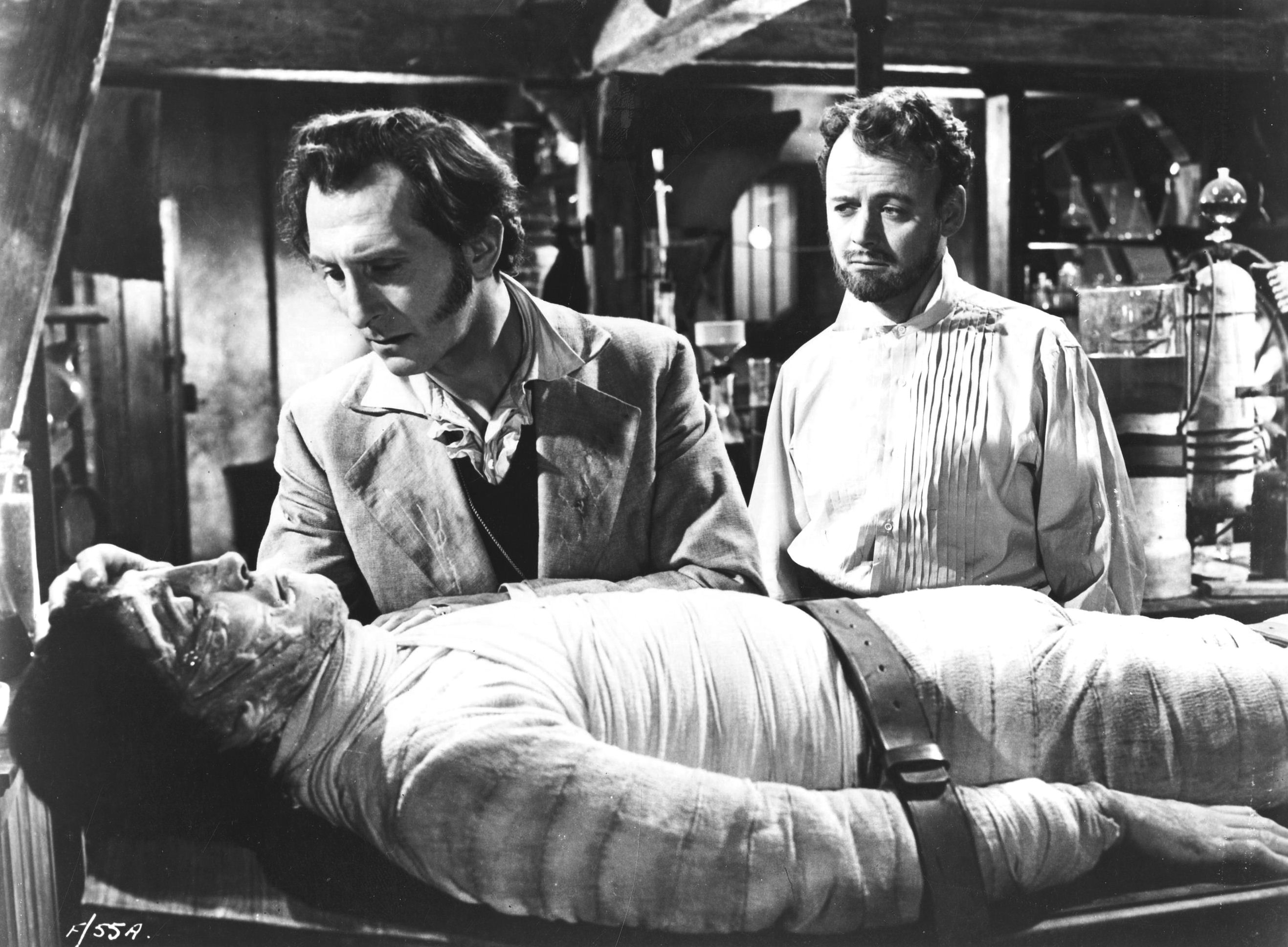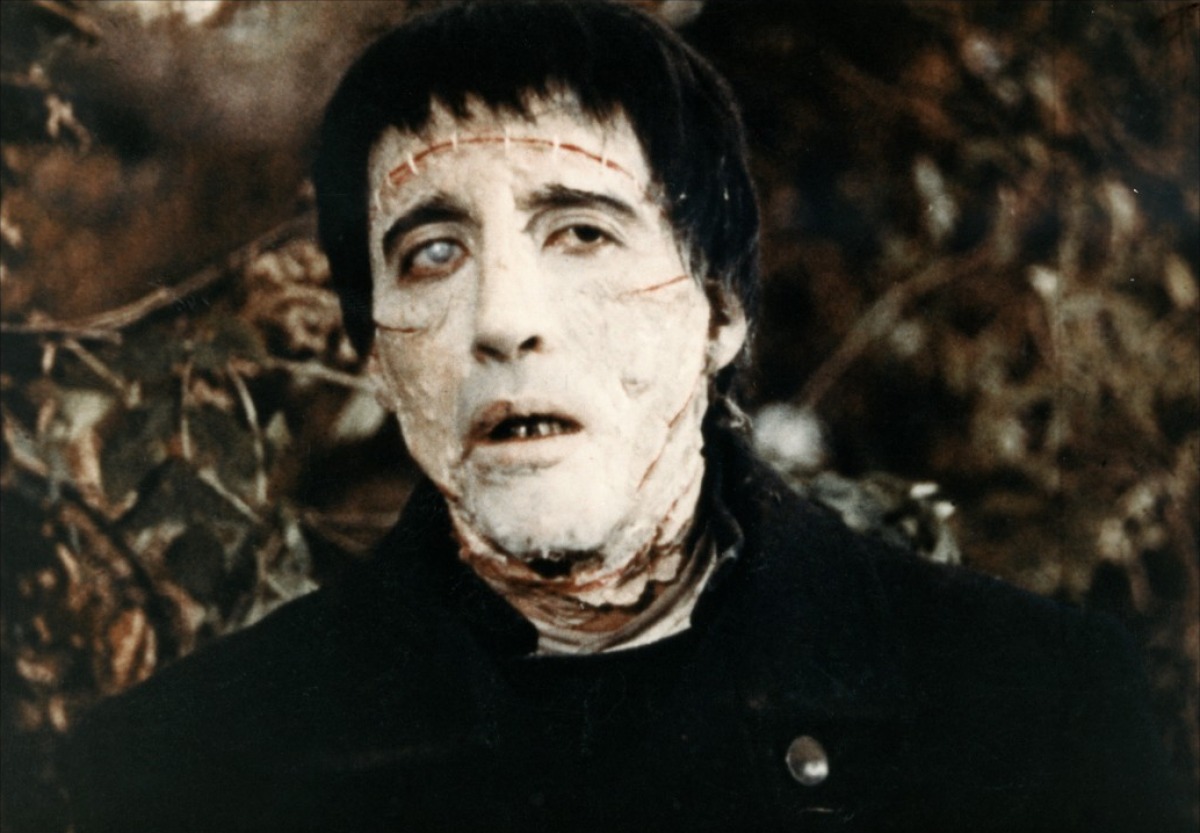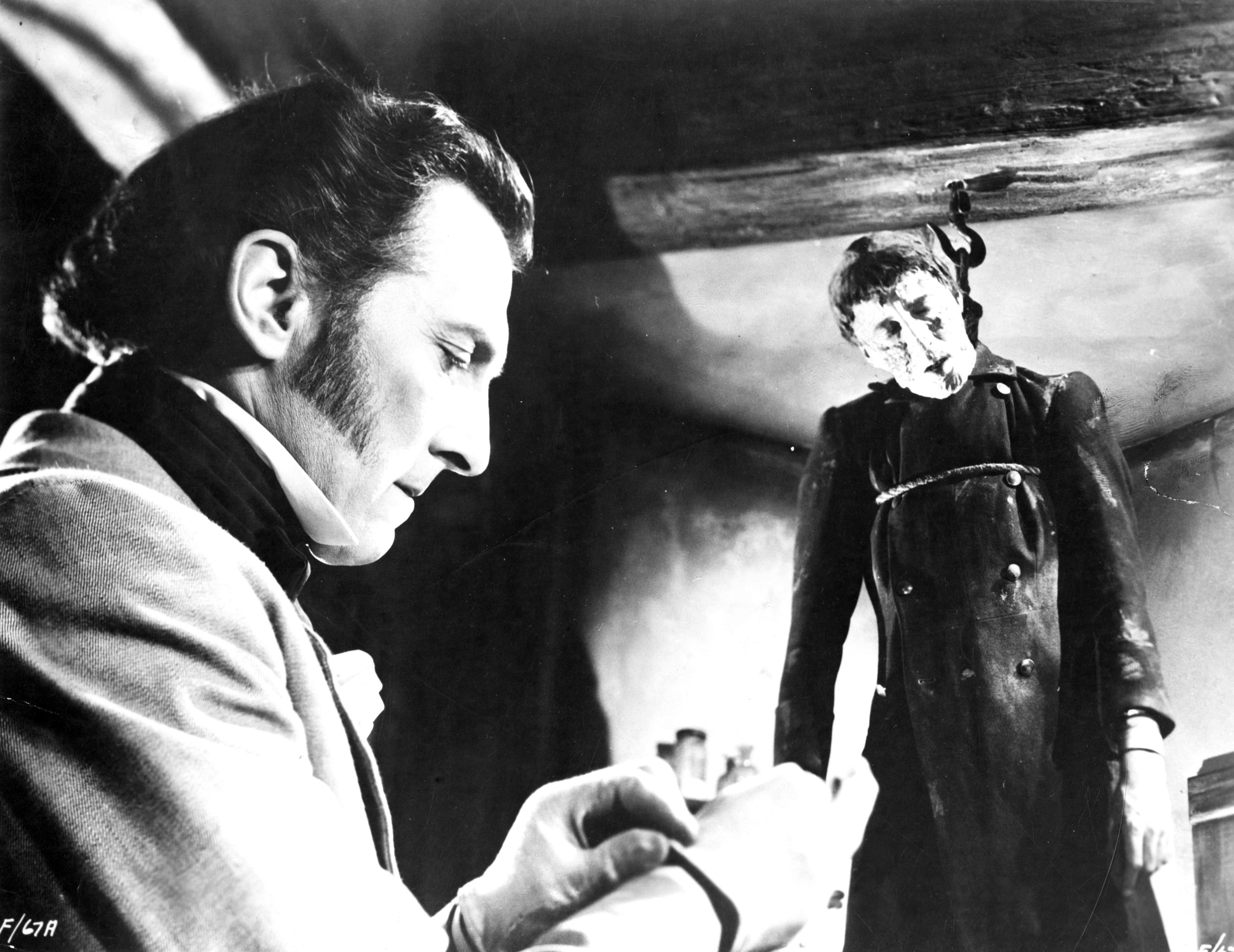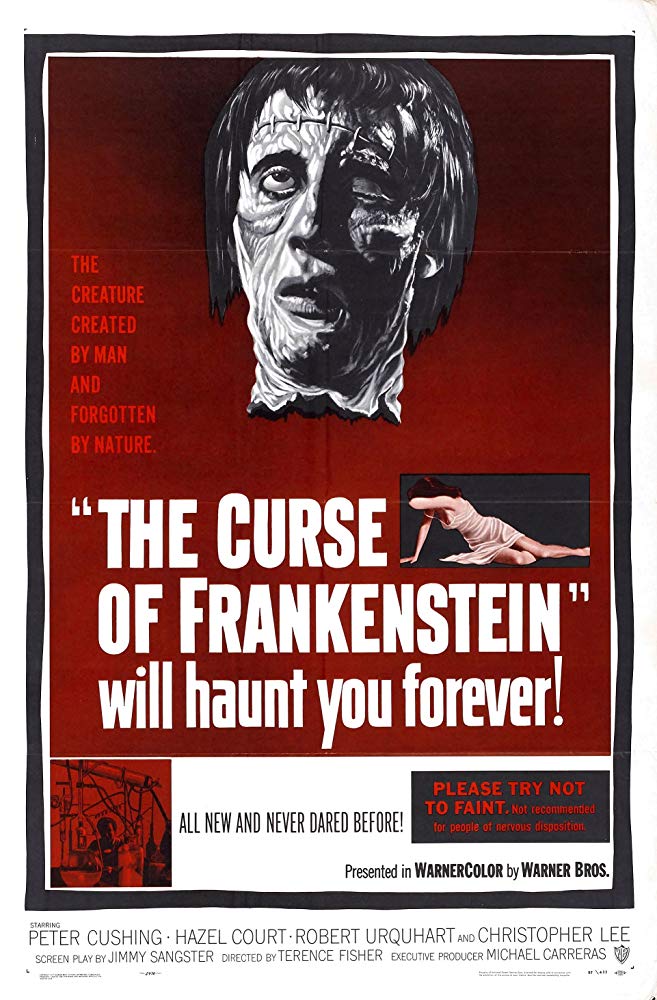UK. 1957.
Crew
Director – Terence Fisher, Screenplay – Jimmy Sangster, Based on the Novel Frankenstein (1818) by Mary Shelley, Producer – Anthony Hinds, Photography – Jack Asher, Music – James Bernard, Music Director – John Hollingsworth, Makeup – Phil Leakey, Production Design – Bernard Robinson. Production Company – Hammer/Clarion Films.
Cast
Peter Cushing (Baron Victor Frankenstein), Robert Urquhart (Paul Krempe), Hazel Court (Elizabeth), Christopher Lee (The Creature), Valerie Gaunt (Justine), Melvyn Hayes (Young Victor), Paul Hardtmuth (Professor Bernstein)
Plot
In a jail cell waiting to be hanged, Baron Victor Frankenstein tells his story to a priest. At a young age, he inherited his father’s estate and he and his tutor Paul Krempe pursued a fascination with medical science. Frankenstein then conceived a plan to revive a body from the dead. He used the corpse of a hanged highwayman and built the perfect body using parts pieced together from other bodies, including pushing the aging Professor Bernstein off a balcony in order to get a good brain. Krempe parted ways with Frankenstein in horror at what he was doing. In attempting to perfect his experiment, Frankenstein was forced to increasingly more ruthless extremes.
This is where it all began – the grand Anglo-horror cycle that lasted throughout the 1960s and most of the 1970s and had influences that reach to the continental Gothic horror revival of the 1960s and Roger Corman’s Edgar Allan Poe films. Most of all, The Curse of Frankenstein is the beginning of the legend of Hammer Films. Hammer had made a number of other films prior to The Curse of Frankenstein dating back to the 1935 – mostly a series of routine thrillers and several films adapted from early British tv shows. They had broached science-fiction with little seen efforts such as Spaceways (1953), Four Sided Triangle (1953) and most famously their Quatermass adaptations The Quatermass Xperiment/The Creeping Unknown (1955) and Quatermass 2/The Enemy from Space (1957). All the cornerstones of the Hammer legend are present here – director Terence Fisher, stars Peter Cushing and Christopher Lee (all three of whom developed a cult following), as well as screenwriter Jimmy Sangster, producers Michael Carreras, Anthony Hinds and Anthony Nelson-Keys, production designer Bernard Robinson and musician James Bernard.
The Curse of Frankenstein, along with the following year’s Dracula/The Horror of Dracula (1958), created a new horror wave that lasted for nearly two decades. Universal Studios had produced its two classic adaptations of Frankenstein and Dracula – Dracula (1931) and Frankenstein (1931) – and had fed off these for nearly two decades. The great Universal horror wave of the 1930s had petered out in the 1940s amid endless sequels, monster team-ups and copycat mad scientist films from the poverty row studios. Aside from the flurry of atomic monster movies in the 1950s, there were almost no horror films made anywhere in the world between 1947 and the genre’s revival in 1957 with The Curse of Frankenstein.
When they came out, The Curse of Frankenstein and Dracula pounded a stake through the staidness of the horror genre’s heart. They were some of the first horror films made in colour; they were graphic about horror (here Frankenstein is shown wrapping up severed hands and purchasing eyeballs).

There was an enormous moral outcry in the British press at the time – the oft-quoted Guardian review “Among the half-dozen most repulsive films I have ever seen” – and the specific creation of an X certificate by the British censor. (Today the films can be seen on US tv with only a G certificate proving that the times really do change).
The Curse of Frankenstein is a markedly different film from the 1931 Universal Frankenstein. Hammer were not able to obtain the copyright on the Jack Pierce makeup used in the 1931 version so they created their own look of the monster, something that proves effectively shocking when unveiled. The most importance difference comes in noticing where the various adaptations place the focus of their story. The Mary Shelley novel is a story about man playing God and denying responsibility for his creation; the 1931 film became a Gothic tale of a scientist defying forbidden knowledge and creating a monster that unleashes social chaos. One is a guilt-ridden divine parable, the other a fear of the social chaos that too much scientific inquiry might produce.
On the other hand, The Curse of Frankenstein is unconcerned with any of this. The society portrayed in the film is not 19th Century Germany so much as it is upper-class 19th/20th Century English society. The Curse of Frankenstein is about driving a spike through the midst of that society’s propriety and mannedness. The film has no interest in creating sympathy for the creation as sad and pitifully manipulated by his creator, nor even in dealing with the Baron’s crises of conscience and responsibility. Instead, the film concerns itself with the utter ruthlessness of the Baron. Terence Fisher goes for all-out shock effect but the shock is not of the monster amok, rather at the increasing ruthlessness of the actions the Baron is prepared to conduct to further his cause. The real horror here is not in challenging forbidden science or monsters unleashed but against social decency.

The measure should be that if you compare the framework from which the story is narrated in the book and here – in the book, Frankenstein is pursued up into the Arctic by his creation, here it is a confession from Frankenstein before he goes to the gallows – you realise that the film in fact affords Frankenstein a much grimmer fate than the one to which Mary Shelley condemned him. Aptly, one of the major differences between Universal and Hammer’s Frankenstein series’ have been the continuing character – for Universal it was the monster, for Hammer it was the Baron – in each case the emphasis comes where the horror is placed. Peter Cushing gives a startling performance, one filled with an arrogant certainty of his own purpose – pushing his mentor off a balcony in order to get a good brain, locking his mistress in with the creature to kill when she tries to blackmail him.
Everything in The Curse of Frankenstein works superbly. From James Bernard’s wonderfully authoritative score to the lush production design – here the film has abandoned the stylised look of the 1931 version for a period realism, something that became one of the distinguishing hallmarks of the Hammer horror film. The creation sequence is good. The cast are all fine – the sole exception being Valerie Gaunt who is miscast as the maid Justine. Gaunt is too peaches-and-cream innocent when the role needs someone who can suggest a sluttiness and manipulative deviousness.
The subsequent Hammer Frankenstein films are:– The Revenge of Frankenstein (1958), The Evil of Frankenstein (1964), Frankenstein Created Woman (1967), Frankenstein Must Be Destroyed (1969), The Horror of Frankenstein (1970) and Frankenstein and the Monster from Hell (1974). Peter Cushing appears as Baron Frankenstein in all of these except The Horror of Frankenstein, which is a lame comedy remake starring Ralph Bates. Hammer also produced Tales of Frankenstein (1958), a 30-minute live tv pilot starring Anton Diffring as the Baron, although no known prints of this exist today. The shot of Peter Cushing looking through the magnifying glass with his eye magnified was directly parodied in Top Secret (1984).

Other Frankenstein adaptations are:– the famous Thomas A. Edison produced silent short Frankenstein (1910); the lost Life Without Soul (1915); the lost Italian The Monster of Frankenstein (1920); the classic Universal adaptation Frankenstein (1931) with Colin Clive as the Baron and Boris Karloff as the monster; Frankenstein (tv movie, 1973) starring Robert Foxworth as the Baron and Bo Svenson as the monster; Frankenstein: The True Story (1974), a lush British tv mini-series starring Leonard Whiting as the Baron and Michael Sarrazin as the creature; the Swedish-Irish production Victor Frankenstein (1977) with Leon Vitali as Frankenstein and Per Oscarsson as the monster; Frankenstein (1984), with Robert Powell as the Baron and David Warner as the monster; the little-seen tv movie Frankenstein (1986) with Carl Beck as Frankenstein and Chris Sarandon as the monster; David Wickes’s dreary tv movie Frankenstein (1992) with Patrick Bergin as the Baron and Randy Quaid as the monster; Kenneth Branagh’s Mary Shelley’s Frankenstein (1994) with himself as the Baron and Robert De Niro as the monster; the tv mini-series Frankenstein (2004) with Alec Newman as Frankenstein and Luke Goss as the monster; Danny Boyle’s stage version of Frankenstein (2011) with Benedict Cumberbatch and Jonny Lee Miller alternating the role of Frankenstein and creation; the low-budget Frankenstein: Day of the Beast (2011) with Adam Stephenson as Frankenstein and Tim Krueger as the monster; Victor Frankenstein (2015) with James McAvoy as Frankenstein; and Guillermo Del Toro’s Frankenstein (2025) with Oscar Isaac as Frankenstein and Jacob Elordi as the creature.
Terence Fisher’s other genre films are:– the sf films Four Sided Triangle (1953) and Spaceways (1953), Dracula/The Horror of Dracula (1958), The Revenge of Frankenstein (1958), The Hound of the Baskervilles (1959), The Man Who Could Cheat Death (1959), The Mummy (1959), The Stranglers of Bombay (1959), The Brides of Dracula (1960), The Two Faces of Dr. Jekyll (1960), The Curse of the Werewolf (1961), The Phantom of the Opera (1962), The Gorgon (1964), Dracula – Prince of Darkness (1966), Frankenstein Created Woman (1967), The Devil Rides Out/The Devil’s Bride (1968), Frankenstein Must Be Destroyed (1969) and Frankenstein and the Monster from Hell (1974), all for Hammer. Outside of Hammer, Fisher has made the Old Dark House comedy The Horror of It All (1964) and the alien invasion films The Earth Dies Screaming (1964), Island of Terror (1966) and Night of the Big Heat (1967).
Jimmy Sangster’s other genre scripts are:– X the Unknown (1956), Dracula/The Horror of Dracula (1958), The Revenge of Frankenstein (1958), The Man Who Could Cheat Death (1959), The Mummy (1959), The Brides of Dracula (1960), the psycho-thrillers A Taste of Fear/Scream of Fear (1961), Paranoiac (1963), Maniac (1963), Nightmare (1964), Hysteria (1965), The Nanny (1965) and Crescendo (1970), and Dracula – Prince of Darkness (1966), all for Hammer. Sangster’s non-Hammer scripts are the medical vampire film Blood of the Vampire (1958), the alien invasion film The Trollenberg Terror/The Crawling Eye (1958), Jack the Ripper (1959), the Grand Guignol psycho-thriller Whoever Slew Auntie Roo? (1972), the tv movie psycho-thrillers A Taste of Evil (1971) and Scream Pretty Peggy (1973), the occult tv movie Good Against Evil (1977), the occult film The Legacy (1979), the spy tv movies Billion Dollar Threat (1979) and Once Upon a Spy (1980), the psycho-thriller Phobia (1980) and the story for Disney’s The Devil and Max Devlin (1981). As director, Sangster made three films:– The Horror of Frankenstein (1970), the lesbian vampire film Lust for a Vampire (1971) and the psycho-thriller Fear in the Night (1972), all at Hammer.
Trailer here


